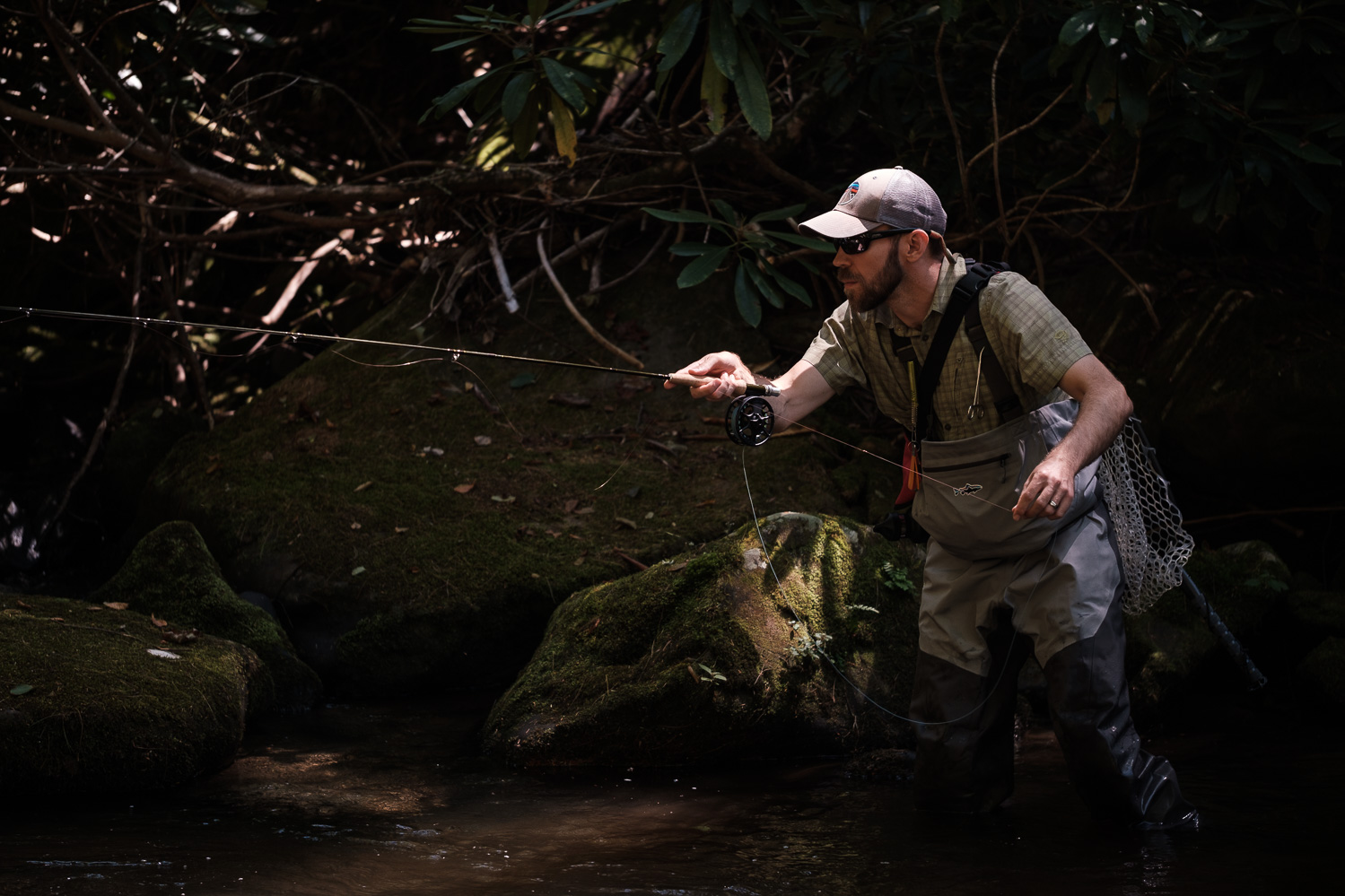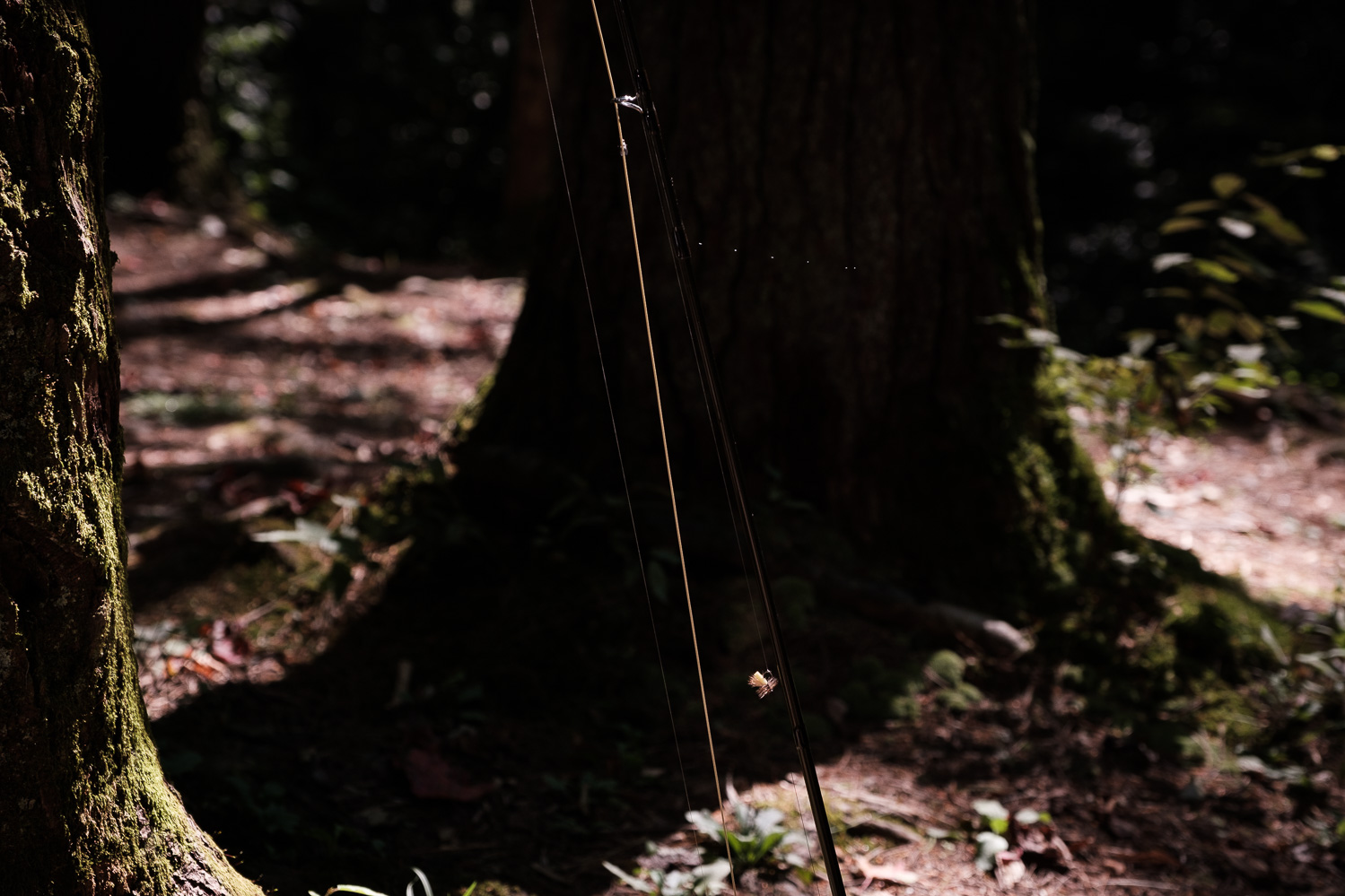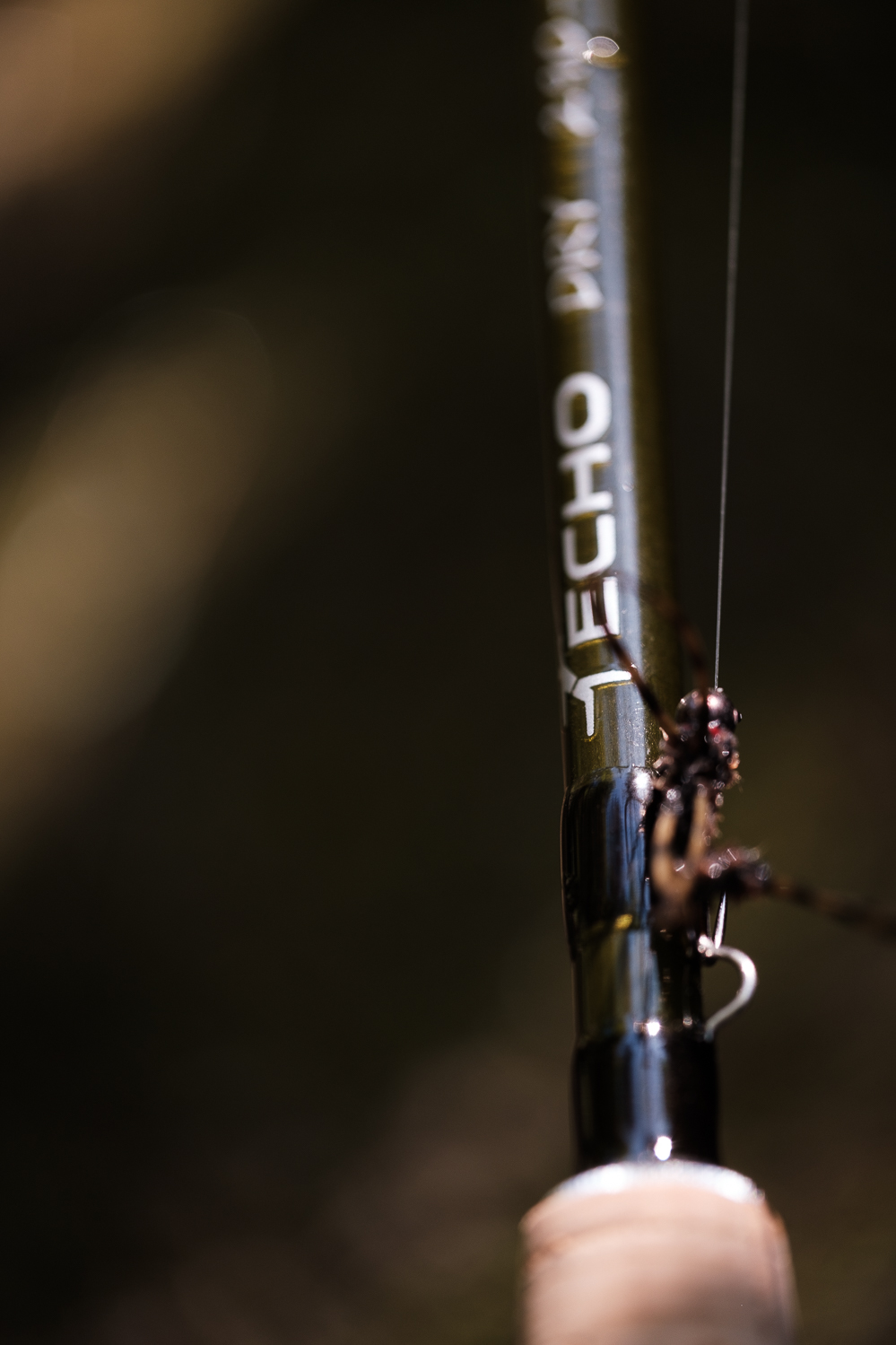Gear Review - Using the ECHO DRY 9' 2wt as a European Nymphing Rod
Dan Wood testing the Echo Dry 9’ 2 wt as a tight-line rod
ECHO DRY 9 foot 2 weight Fly Rod for tight-lining
I have slowly evolved from traditional fly casting to a mono-rig (aka Euro rig, European nymphing, tight-line nymphing, tight-lining, Mono-rig, etc). Even in the tight-quarters and rhododendron and mountain-laurel choked home waters here in Georgia, I’ve found more confidence when I am fishing in this method. So much so that I lose that “on” feeling when I use a standard in-line nymph rig with an indicator on traditional, floating line.
Current Rods for Tight-lining
As most folks who fish this way will tell you, you can certainly use any rod to tight-line. However, in my experience, certain rods work better - those with backbone in the butt section and the length and action to allow snappy casts. A sensitive tip is also vital for subtle strike detection. More length allows for better reach and keeping your flies in the right zone for longer periods of time. Lighter weight means less fatigue and easier balance with todays modern and lighter reels. From here forward note that I use the words mono-rig (credit to Domenick Swentosky over at Troutbitten), tight-line, and euro-nymph interchangeably. My rod evolution as I started tight-lining:
Sage Launch 9’ 5 wt with a custom tied leader. This was my go to rod at the time I started tight-lining. I did not want to spend money on a whole new rod if I did not end up liking tight-lining. The leader that Devin Olsen ties at Tactical Fly Fisher was the perfect ticket. I dedicated a day to trying it on a trip to South Fork, CO. After an hour of practicing, I felt fairly comfortable with the cast and the drift. As I stood in the middle of the Rio Grande, fishing runs on both side of me and picking fish up every few casts without having to move much at all, I was sold
Cortland Competition 10’6” 3 wt with Cortland competition line. This was my first foray into a longer rod without breaking the bank. I mentioned my interest in it, and my awesome wife had it wrapped and ready for my birthday. I spent a lot of time with this rod on the local tailwater but over time felt like it was a bit too tip heavy and I did not have a heavy reel to balance it. I was also concerned about the sensitivity of it and was worried it wouldn’t serve well for traditional casting if I needed it to.
Orvis Recon 10’ 4 wt with the same reel and line as #2. As my technique and confidence in tight-lining grew, I knew more what I wanted in a rod. I wanted 10’ or more in length, backbone, sensitivity, and lightweight all with the ability to cast in a standard manner if I needed to. After doing a bit of searching, I landed on the Recon. This is now my go to rod for almost all fishing, whether I am tight-lining or standard casting on mountain streams or from the drift boat. It is an incredible rod.
Of the 3 above, I tend towards the Recon - it just has a more sensitive tip and is an all around better rod than the other two for tight-lining, but I can also quickly switch my reel or spool to standard line and have an awesome-casting rod for dry fly situations. I also use the Recon as my boat rod - it roll casts and mends like a dream.
Why I chose the Echo Dry 9’ 2 wt
Despite my satisfaction with the Orvis Recon 10’ 4 wt, I found it’s length to be a bit cumbersome on smaller streams with more overhang, and a bit too much rod for some of the smaller fish in those streams. I really wanted to find a light rod with the length to do more tight-lining on said smaller streams.
Orvis now makes a tight-line specific 10' 3 wt Recon, and I almost went for it. But I really wanted to have a rod that could both tight-line and cast dry droppers, and fit better in the smaller mountain streams. The 10’ length was a bit too much. Moonshine also makes a euro-nymph rod, but again I was hesitant at it’s ability to cast a standard rig (I’m sure it can, I’ve just never casted it). It is also 10’ long.
Enter the Echo Dry 9’ 2 wt. When I Googled “9 ft 2 wt fly rod” this is what popped up first. I’ve heard good things about Echo, and my buddy fishes one of their tight-line specific rods and loves it. It hits at a good price point too ($229). I could not find another rod company making a 2 weight 9 foot rod. I pulled the trigger, and told my wife, and once again got it as a present (yes, she is awesome).
Echo DRY 9 ft 2 wt as a tight-line rig
How Did it Perform?
This past week I had the chance to really test it for 2 days on my all-time favorite mountain stream. This particular stream is all wild, catch-and-release, with single hook regulations and is a testament to good stream management. Fish run anywhere from 1-2” stream-born fingerlings to 20”+ trout.
And I once hooked and nearly landed one of those 20”+ fish — a wild-as-they-come stream-born kype-jawed brown. I hooked him fishing a tight-line rig, and brought him to my too-small net on the Recon above, and as it hit the bottom of the net, it made a reverse-belly-flop and in slow motion I watched as it dove into the water, my barbless hook flying out the other way, and after a desperate attempt to get my net in position before it swam off, we watched it lazily return to the depths without much more than the flash of memory in my mind.
Knowing that those beasts are in there but far and few between, I dedicated the two days to fishing the Echo Dry 9’ 2 wt.
Traditional Casting
The water was quite low and clear, and I actually started off with my floating weight-forward line, with an inline dry-dropper set up. It casts like a dream, roll casts even better, and handled up to the 12” rainbow I landed the first day without difficulty. I will say that I taught myself to cast years back, and small-streams being my stomping grounds, developed a slight-side-arm cast that can still haunt me to this day.
The Echo seems to magnify my mistakes and I found my poorer casts to really hook to the right. But overall, it was an absolute joy to cast and made very tight loops when I slowed my cast down. My buddy fishing with me that day was using his fiberglass rod, and I found myself launching roll casts with ease compared to his glass (in fairness, his rod was a 6’ 6” 4 wt). It is also so limber and loads deeper into the rod, making bow-and-arrow casting a bit more challenging.
Ultimately, it is so light and long, it excels as a small stream dry-dropper rod. But this is not why I purchased it.
Tight-lining
As I mentioned earlier, I wanted to use this rod with my tight-line set up. The fishing the day before was so stellar on dry-dropper, I left the same rig on. Whether it was the stretch we decided to fish, or the cool mountain air changing the morning bite, the dry-dropper was much less effective then the afternoon before.
After 3 of us flogged the pocket water that was so productive the day before, only to watch deeper runs go uncontested because our droppers were not long enough, I made the decision to switch over to a tight-line set up. It took me all of 5 minutes or so to change reels and get rigged. It was a good decision.
I cast my usual, fairly heavy double nymph rig (a size 8 tungsten-head Pat’s rubber leg tied on a barbless jig hook and a size 14 tungsten-head modified Walts Worm as the tag), and the Echo Dry handled it with ease. After a few casts to get the feel, I was making comfortable casts a rods length away and further.
It has a bit less sensitivity than the Recon because the tip is so limber, but more so than the Cortland. I found I had to put a bit more into the hook set because of the give in the rod, which is fine. I immediately started picking up more hookups than the other two guys casting dry-droppers.
And in the deeper water and spill outs, the rod was put to the test. Just as we were about to hop over a deeper run, I asked to fish out of turn since neither of the guys had deeper rigs on. They were happy to oblige and I am glad they did. As soon as my rig landed in the wash of the spill-out, I lifted the rod tip and immediately felt the slow pull of a larger trout (or snag) instead of the wild head shake of their smaller brethren.
Large, feisty wild brown caught tight-lining using the Echo Dry 9 ft 2 wt
I estimate this brown to be somewhere close to 15” and the ECHO DRY 2 wt had the backbone to handle it. It actually pulled drag a few times but the rod stepped up when I needed it.
I am now absolutely sold on the ECHO DRY 9’ 2 wt as the perfect small stream rod for both traditional casting and tight-lining. I actually had a 3rd tag tied off the connection to the leader with a dry fly on it, and had a few takes on the dry as well while maintaining connection with my nymphs. It was the perfect hybrid setup. From here going forward, I plan on this being my main small stream stick and I’ll carry an extra reel or spool to switch to a weight forward line if the situation absolutely demands it.
A few notes - you do NOT need to overline this rod. I started with a 3 wt line, and while it casted well, I felt like my drifts were more difficult as the line out the guides felt heavier. I switched back to a 2 wt line and the over-correction of my cast I mentioned earlier was not as prominent, and I felt like I had overall better control.
Pros
Lightweight
Cast’s a dry-dropper rig effortlessly
Roll casts in tight quarters well thanks to longer length and rod action
Works stunningly well as a European nymphing or tight-line rod for small streams
Has the backbone (and soft tip) to land big fish
Aesthetically pleasing
Guides are friction-free - mono-rig leader with it’s various knots had no problem sliding through the guides
Inexpensive
Cons
Seems to intensify errors in my casting with a traditional floating line, over-correcting my side-arm cast to the right (I’m left handed)
Uber soft tip - not so much a con as a technique issue, but I believe I missed a few because my hook set needed to be stronger
I would say if you’re interested in the Echo Dry 9 ft 2 wt - and especially if you’re curious if it will work for small stream European or tightline nymphing - do not hesitate. At this price point, it is a fantastic rod.
Echo DRY 9 ft 2 wt handled casting a tungsten-head Pat’s rubber legs without difficulty





